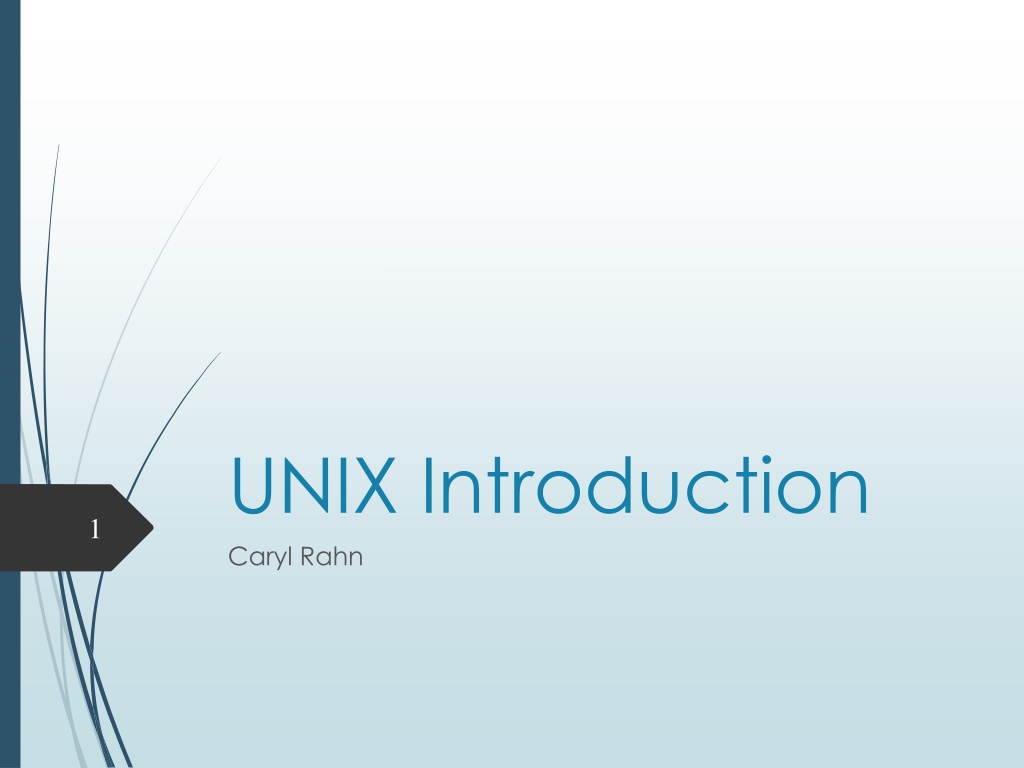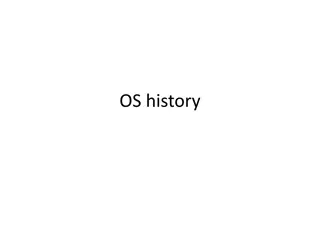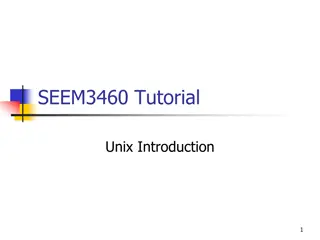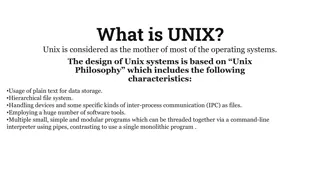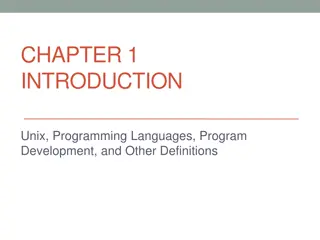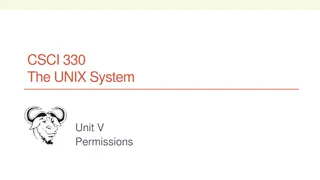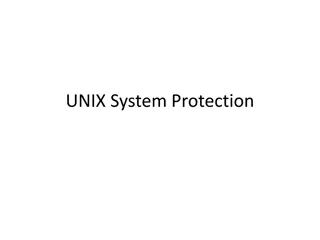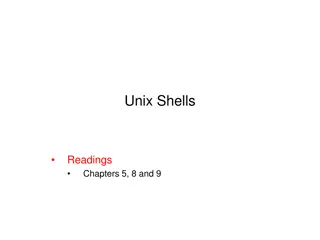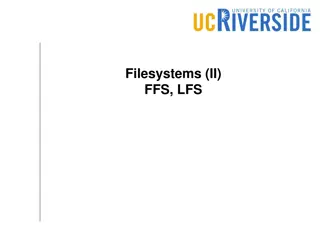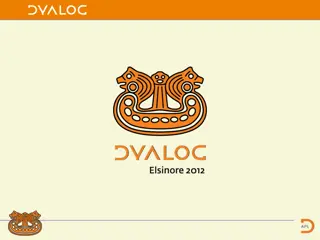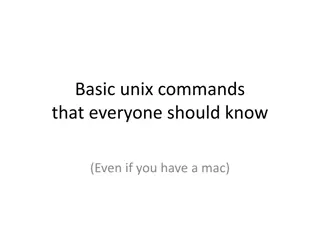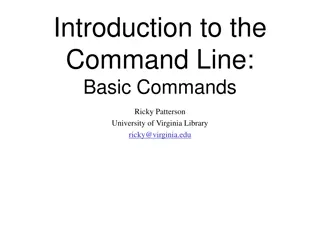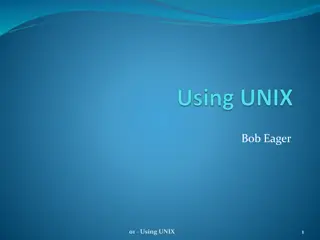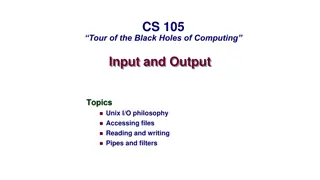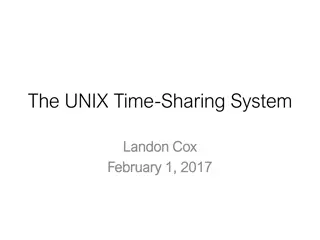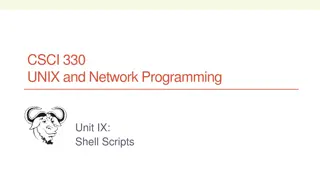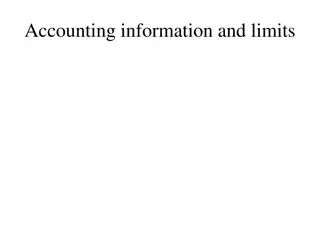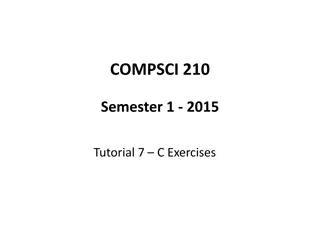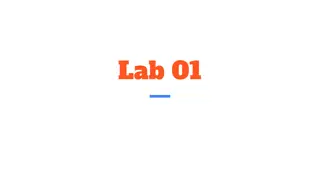Understanding UNIX Operating System
UNIX is a versatile operating system that enables multi-user access, multitasking, and portability across various computing environments. It serves as the foundation for many modern operating systems and has influenced concepts incorporated in Microsoft Windows and DOS. The UNIX system comprises distinct layers, with the kernel as the core component interacting directly with hardware. Users interact with UNIX through shells, which act as interfaces between users and the operating system, facilitating communication and executing commands. Understanding the layers, functions of shells, and the overall architecture of UNIX is essential for users to effectively utilize and navigate this powerful operating system.
Uploaded on Sep 25, 2024 | 0 Views
Download Presentation

Please find below an Image/Link to download the presentation.
The content on the website is provided AS IS for your information and personal use only. It may not be sold, licensed, or shared on other websites without obtaining consent from the author. Download presentation by click this link. If you encounter any issues during the download, it is possible that the publisher has removed the file from their server.
E N D
Presentation Transcript
UNIX Introduction Caryl Rahn 1
UNIX and Linux 2 Backround Layers of a UNIX System Function of UNIX Shells Options for Connecting to a UNIX System Syntax used for Entering UNIX Commands Role of the System Administrator Log On and Log Out Redirection Symbol
Introducing the UNIX Operating System 3 UNIX is a multi-user system Lets many people simultaneously access and share the resources of a server computer UNIX is a multitasking system Lets one user execute multiple programs UNIX is also a portable operating system Can be used in a variety of computing environments (different types of hardware) It is the only operating system that spans all classes of computers from mainframes to PDAs.
UNIX Concepts 4 Microsoft DOS and Microsoft Windows adopted original UNIX design concepts, such as the idea of a shell--an interface between the user and the operating system--and the hierarchical structure of directories and subdirectories The kernel is the base operating system, which interacts directly with the hardware and services the user programs
Unix Concepts - Layers 5 The kernel is only accessible through kernel mode - reserved for system administrator This prevents unauthorized commands from invading the foundation layer or the hardware that supports the entire UNIX structure User mode provides access to higher layers where all application software resides
Functions of UNIX Shells 7 Used to Communicate between the user and the Operating System Two major types of Shells GUI Graphical User Interface CLI Command Line Interface
Graphical User Interface GUI 8 X Windows System Common Desktop Environment CDE Fast Virtual Window Manager (fvwm) Linux Open Look Window Manager (olwm) Sun Microsystems K Desktop Environement KDE Open Windows What is the most common GUI running a UNIX system?
Command Line Interface CLI You choose a shell when the system administrator sets up your user account Most users choose the Bash shell, although you can choose any of these: Bourne Shell (sh) first one at AT&T C Shell (csh) C programmers like this one TC Shell (tcsh) derived from the C shell Korn Shell (ksh) - includes many extensions, such as a history feature that lets you use a keyboard shortcut to retrieve commands you previously entered Bourne again Shell (bash) Linux Start-up scripts are different for the different shells 9
Options for Connection to a UNIX System 10 Workstation Usually run versions of UNIX specifically for that workstation - Sun-OS, Solaris, HP_UX Personal Computer There are several versions of UNIX that run on PC s - Solaris, UNIXware, XENIX Dumb Terminal
Making the Connection 11 LAN Connection Appears as if the local computer is running UNIX Telnet Connection A client program connects to a telnet server running on the UNIX system. Appears like a dumb terminal Can run over a Network Connection or a modem
Connecting to UNIX via Telnet 12 Telnet is a terminal emulation program for the Internet putty Internet Protocol (IP) address Domain name such as ocelot.aul.fiu.edu
Syntax used for Entering UNIX Commands 13 UNIX is Case Sensitive! Launch Applications from the CDE CLI Syntax Enter the program (command) on the command line ls l vi myfile.txt
Role of the System Administrator 14 Sets up access and permissions for Users of the System You can log on to any UNIX or Linux system as long as you have a user account and password on the host (server) computer Perform System Backups Install and Upgrade Programs a.k.a. superuser
The System Administrator Continued 15 The system administrator has a unique user name: root The system administrator owns the root account, which means no one else can be assigned to that account The password for the root account should be confidential; only the system administrator and a back-up person know it
The System Administrator Command Line 16 The system administrator s prompt is the # (pound) symbol The UNIX system generates a default setting for the command prompt for the system administrator in the following format: [root@hostname]#
The Ordinary User Command Line 17 The $ (dollar sign) is traditionally associated with ordinary users The UNIX system generates a default setting for the command prompt for ordinary users in the following format: [user name@hostname]$
Users and Groups 18 /etc/passwd Contains user login name Password is encrypted There is a User ID number (UID) that is unique, set by the System Administrator Has the users primary group ID Has the users home directory Has the users logon shell /etc/group Contains groups and their members
Setting File Permissions 19 A directory listing gives you the access permissions for a file. The first character of file type can be d directory b,c or p for devices A hyphen means it is a file chmod ugoa =+- rwx filename
File Permission Codes Diagram on Previous Slide 20 d R w x Indicates the file type (d=directory) File s owner has read permission File s owner has write permission File s owner has execute permission (can run the file as an executable program) r Group has read permission - Group does not have write permission x Group has execute permission r Others have read permission - Others do not have write permission x Others have execute permission
Entering Commands 21 UNIX is case-sensitive You type most UNIX commands in lowercase You must know a command s syntax Syntax Command options arguments ls alt /usr/users/*
Multiple Commands 22 You may type more than one command on the command line by separating each command with a semicolon(;) When you press Enter, UNIX executes the commands in the order you entered them
Command Line Entry Continued 23 The clear Command You can use the clear command to clear your screen; it has no options or arguments The Command-line History You can access the command history with the up and down arrow keys Pressing the up arrow key once recalls the most recently used command Each time you press the up arrow key, you recall an older command
Commonly Used Shell Commands - man 24 All UNIX systems include man pages Online help manual Syntax man ls This is probably the most important command to learn!
man Pages 25 Name: the name of the command and a short statement describing its purpose Synopsis: a syntax diagram showing the usage of the command Description: a more detailed description of the command than the name item gives Options: a list of command options and their purposes See Also: other commands or man pages that provide related information Bugs: a list of the command s known bugs
Commonly Used Shell Commands - logout 26 Logging out ends your current process and indicates to UNIX that you are finished How you log out depends on the shell you are using exit logout
Commonly Used Shell Commands - passwd 27 passwd command new password must differ from the old password by at least three characters password must have more than five characters at least two letters and one number password is different from your user name
Commonly Used Shell Commands 28 Three UNIX commands let you view the contents of files: cat, more, and less The more and less commands display a file, one screenful at a time, while the cat command displays the whole file at once Two other commands, head and tail, let you view the first few or last few lines of a file
Commonly Used Shell Commands - cal 29 cal cal j 2000 julian date format cal august 2002 calendar of august, 2002 calendar of the current month
Commonly Used Shell Commands - date 30 date today s date date u system date
Commonly Used Shell Commands - who 31 who h Displays remote users logged in who i Shows idle time for each user who iH List of login names and total # who -q Your username and what terminal you are logged into
More Commonly Used Shell Commands 32 pwd print working directory cd ls touch whatis clear find
Redirection Symbol 33 > cat > myfile.txt >> cat >> myfile.txt Ctrl D
The UNIX File System 34 Standard Tree Structure Partitions Mount Paths and Pathnames Creating Directories Copying Files Setting File Permissions
UNIX File Types 36 Everything looks like a file to UNIX There are 4 Types of Files Binary Files Text Files Links Device Files
Partitions 37 Can have one or more partitions Having different partitions protects your data Root partition /etc and /bin Partition for users home directories Other partitions /home /var /tmp /usr /swap
The Swap Partition 38 Swap partitions support virtual memory Virtual memory swap partitions prove space on disk that acts like an extension of physical memory The system can use it to swap information between disk and RAM The rule of thumb is: Swap space = 3 x RAM
The /bin and /boot Directories 39 The /bin Directory The /bin directory contains binaries, or executables, the programs needed to start the system and perform other essential system tasks The /boot Directory The /boot directory often contains the files that the bootstrap loader (the utility that starts the operating system) needs and the kernel (operating system) images
The /dev Directory 40 The /dev Directory Files in the /dev are device drivers, which access system devices and resources such as hard disks, the mouse, printers, consoles, modems, memory, floppy disks, and the CD-ROM drive The device files are divided into two major classifications: block and character types
The /etc Directory 41 The /etc directory contains configuration files the system uses when the computer starts Most of this directory is reserved for the system administrator, and it contains system- critical information stored in files: psswrd, the user database (passwd) rc, scripts or directories of scripts to run when the system starts Fstab, lists of file systems mounted automatically when the system starts group, the user group database
The /lib Directory 42 This directory houses the shared library images, files that programmers generally use to share code in the libraries rather than creating copies of this code in programs This makes the programs smaller and faster Many files in this directory are symbolic links to files in system libraries A symbolic link is a name that points to and lets user access a file located in a directory other than the current directory
The /mnt and /proc Directories 43 The /mnt Directory Mount points for temporary mounts by the system administrator reside in the /mnt directory This directory is often divided into subdirectories such as /mnt/cdrom and /mnt/floppy, to clearly specify device types The /proc Directory The /proc directory occupies no space on the disk: it is a virtual file system allocated in memory only
The /root and /sbin Directories 44 The /root Directory The /root directory is the home directory for the user root, usually the system administrator The /sbin Directory The /sbin directory is reserved for the system administrator
The /tmp Directory 45 The /tmp Directory Many programs need a temporary place to store data during processing cycles The traditional location for these files is the /tmp directory
Mount 46 The root(/) file system is mounted by the kernel when the system starts Other file systems can be attached to your system using the mount command The mount point is an empty directory The mount command maps the new file system to the mount point
Mount Continued 47 The system administrator uses the mount command to mount a file system Syntax: mount device-name mount-point mount t cdfs r /dev/cdrom /mnt/cdrom Mounts the cdrom mount /dev/fd0 /mnt/floppy Mounts the floppy disk df lists all mounted file systems
Paths and Pathnames 48 Absolute Pathnames Begins at the root level and lists all subdirectories to the destination file Relative Pathnames Starts from the current point A forward slash (/) separates each directory name
Miscellaneous File Info 49 . current directory .. up one directory * wildcard matches anything
Creating Directories 50 mkdir can create one or more directories rmdir remove one or more directories Be very careful deleting files and directories, they are really gone.
